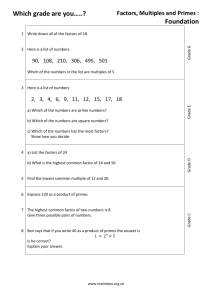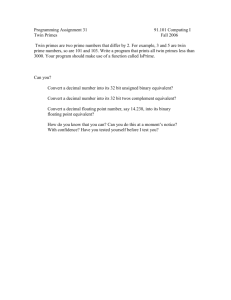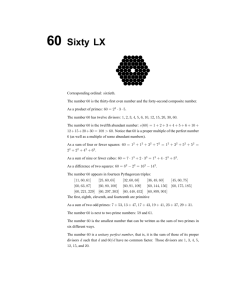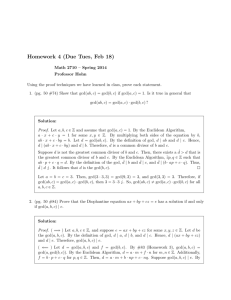Primes and Zeta
advertisement
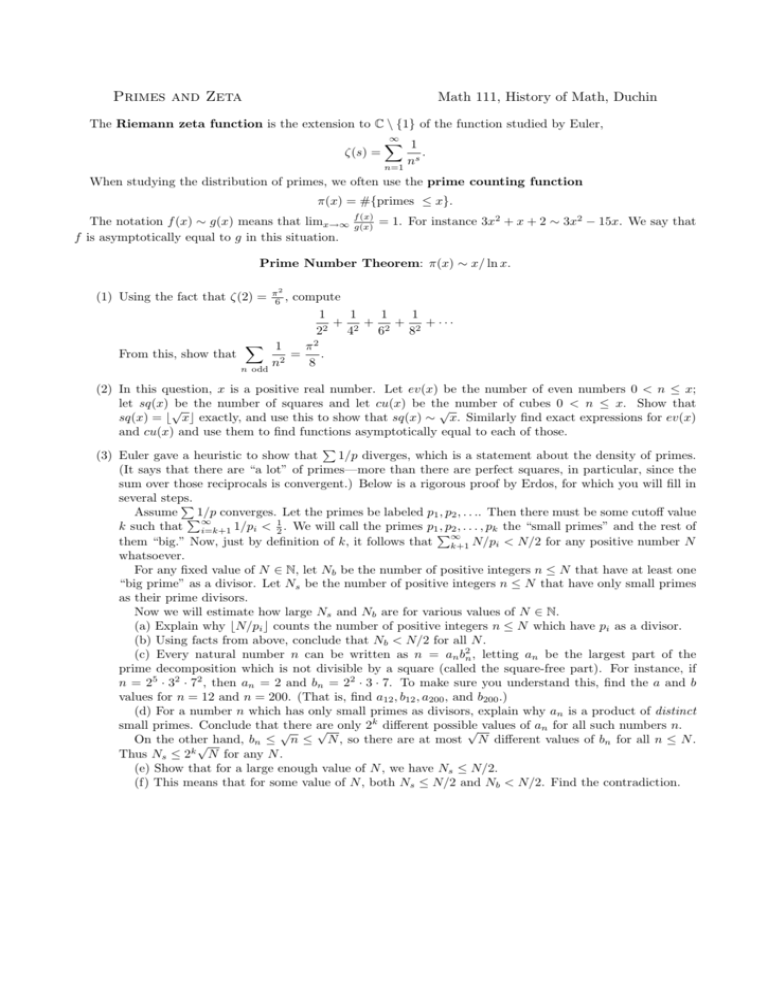
Math 111, History of Math, Duchin
Primes and Zeta
The Riemann zeta function is the extension to C \ {1} of the function studied by Euler,
∞
X
1
.
ζ(s) =
s
n
n=1
When studying the distribution of primes, we often use the prime counting function
π(x) = #{primes ≤ x}.
The notation f (x) ∼ g(x) means that limx→∞
f is asymptotically equal to g in this situation.
f (x)
g(x)
= 1. For instance 3x2 + x + 2 ∼ 3x2 − 15x. We say that
Prime Number Theorem: π(x) ∼ x/ ln x.
(1) Using the fact that ζ(2) =
π2
6 ,
compute
1
1
1
1
+ 2 + 2 + 2 + ···
22
4
6
8
From this, show that
X 1
π2
=
.
2
n
8
n odd
(2) In this question, x is a positive real number. Let ev(x) be the number of even numbers 0 < n ≤ x;
let sq(x) √
be the number of squares and let cu(x) be the
√ number of cubes 0 < n ≤ x. Show that
sq(x) = b xc exactly, and use this to show that sq(x) ∼ x. Similarly find exact expressions for ev(x)
and cu(x) and use them to find functions asymptotically equal to each of those.
P
(3) Euler gave a heuristic to show that
1/p diverges, which is a statement about the density of primes.
(It says that there are “a lot” of primes—more than there are perfect squares, in particular, since the
sum over those reciprocals is convergent.) Below is a rigorous proof by Erdos, for which you will fill in
several steps.
P
Assume P1/p converges. Let the primes be labeled p1 , p2 , . . .. Then there must be some cutoff value
∞
k such that i=k+1 1/pi < 12 . We will call the primes p1 , p2 , . . . , pk the “small primes” and the rest of
P∞
them “big.” Now, just by definition of k, it follows that k+1 N/pi < N/2 for any positive number N
whatsoever.
For any fixed value of N ∈ N, let Nb be the number of positive integers n ≤ N that have at least one
“big prime” as a divisor. Let Ns be the number of positive integers n ≤ N that have only small primes
as their prime divisors.
Now we will estimate how large Ns and Nb are for various values of N ∈ N.
(a) Explain why bN/pi c counts the number of positive integers n ≤ N which have pi as a divisor.
(b) Using facts from above, conclude that Nb < N/2 for all N .
(c) Every natural number n can be written as n = an b2n , letting an be the largest part of the
prime decomposition which is not divisible by a square (called the square-free part). For instance, if
n = 25 · 32 · 72 , then an = 2 and bn = 22 · 3 · 7. To make sure you understand this, find the a and b
values for n = 12 and n = 200. (That is, find a12 , b12 , a200 , and b200 .)
(d) For a number n which has only small primes as divisors, explain why an is a product of distinct
k
small primes. Conclude that there are
√ only 2 different possible
√ values of an for all such numbers n.
√
n
≤
N
,
so
there
are
at
most
N different values of bn for all n ≤ N .
On the other
hand,
b
≤
n
√
Thus Ns ≤ 2k N for any N .
(e) Show that for a large enough value of N , we have Ns ≤ N/2.
(f) This means that for some value of N , both Ns ≤ N/2 and Nb < N/2. Find the contradiction.



